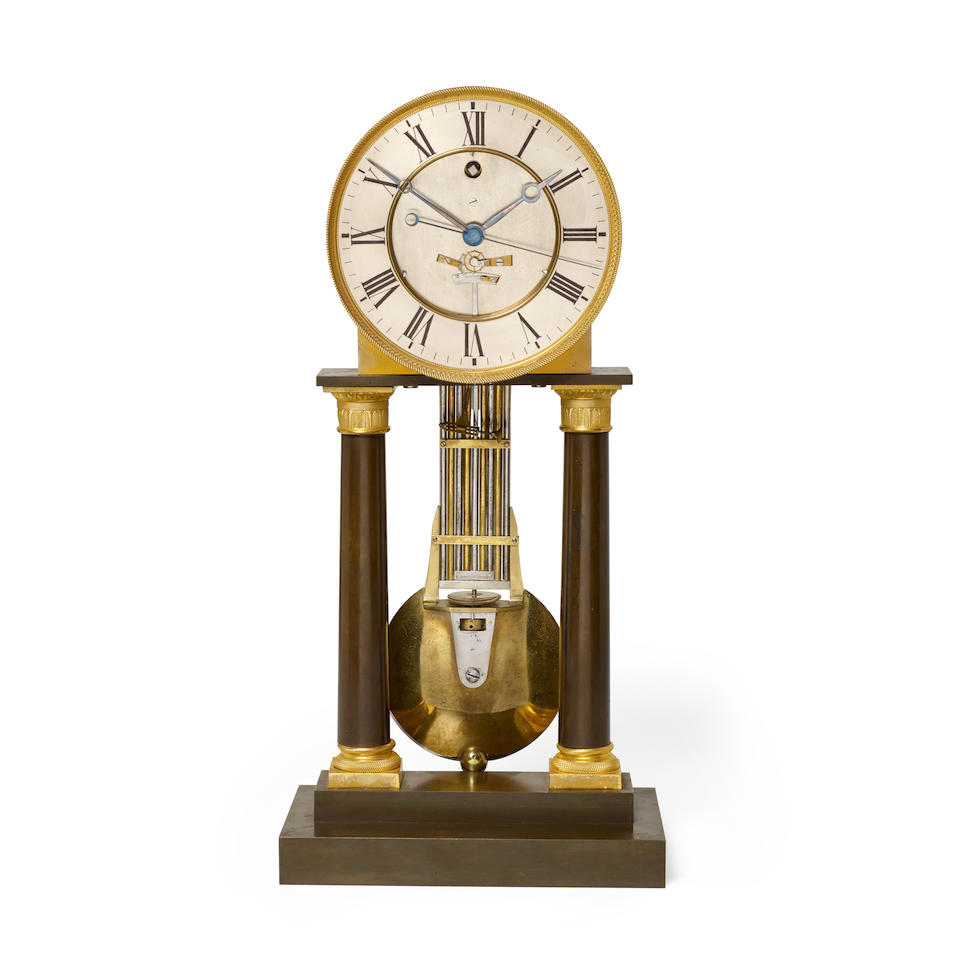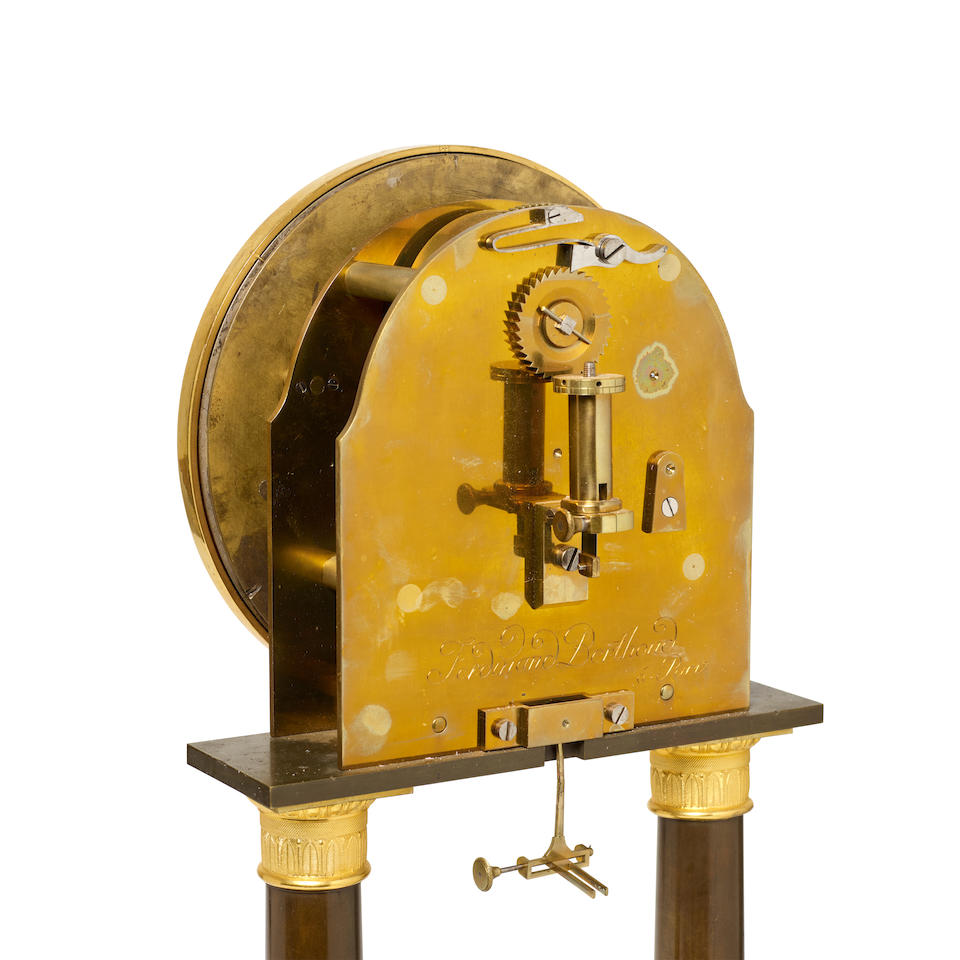27
A FINE AND RARE EARLY 19TH CENTURY GILT AND PATINATED BRASS TABLE REGULATOR OF ONE MONTH DURATIO...
In Fine Clocks
A FINE AND RARE EARLY 19TH CENTURY GILT AND PATINATED BRASS TABLE REGULATOR OF ONE MONTH DURATION WITH VISIBLE COUP PERDU ESCAPEMENT AND HEAVY GRIDIRON PENDULUM Ferdinand Berthoud a Paris The 6.25 inch silvered Roman dial within an engine turned bezel and with recessed centre containing the visible coup perdu escapement of brass 'scape wheel and highly polished steelwork, with blued steel Breguet-style hands and counterbalanced centre seconds hand; set on a pair of twin patinated tapering columns with gilt capitals and bases on a stepped rectangular plinth. The movement with slightly shouldered arched plates united by four turned and two shaped brass pillars, the large going barrel at the top of the plates, with heavy nine-rod steel and brass gridiron pendulum suspended from a heavy block mounted on the backplate with rise and fall adjustment and terminating in a 5-inch lenticular brass bob with further fine screw adjustment within the body of the bob. The backplate signed along the lower edge Ferdinand Berthoud a Paris 46cms (18.5ins) high. Footnotes: Ferdinand Berthoud (1727-1807) was one of the most important horologists of the 18th century. Born in Neuchâtel and trained as a watchmaker. He emigrated to France in 1745 working as a journeyman for the Paris trade. His talents led to being received as a master watchmaker by the Paris guild in 1753. He was a prolific author, writing notably on timepieces to measure Time at sea to determine longitude. He developed his own marine chronometers that met with great success. In 1773, Berthoud published his Traité des horloges marines contenant la théorie, la construction, la main-d'œuvre de ces machines et la manière de les éprouver, pour parvenir par leur moyen, à la rectification des cartes marines et à la détermination des longitudes en mer. This treatise was a first, detailing all the parts required for building a sea clock. It helped seal the reputation of Berthoud's work, in particular with respect to his competitors in longitude at sea research, such as John Harrison and Pierre Le Roy. His 1763 Essai sur l'horlogerie is still highly regarded. Near the end of his life, he wrote a monumental Histoire de la mesure du temps par les horloges. A coup perdu escapement converts a half-second beating pendulum to directly control an escape wheel at the rate of a one second pendulum, so only every other beat is registered by the escape wheel. In other words, there is a 'lost beat'. For a discussion of the clock and a diagram of the escapement, see: Derek Roberts. Continental and American Skeleton Clocks, pp 25-26, fig. 12a, b Another example of this timepiece was sold in Bonhams New York 6 December 2018, lot 91 for $37,500. This lot is subject to the following lot symbols: * * VAT on imported items at a preferential rate of 5% on Hammer Price and the prevailing rate on Buyer's Premium. For further information on this lot please visit Bonhams.com For further information about this lot please visit the lot listing
A FINE AND RARE EARLY 19TH CENTURY GILT AND PATINATED BRASS TABLE REGULATOR OF ONE MONTH DURATION WITH VISIBLE COUP PERDU ESCAPEMENT AND HEAVY GRIDIRON PENDULUM Ferdinand Berthoud a Paris The 6.25 inch silvered Roman dial within an engine turned bezel and with recessed centre containing the visible coup perdu escapement of brass 'scape wheel and highly polished steelwork, with blued steel Breguet-style hands and counterbalanced centre seconds hand; set on a pair of twin patinated tapering columns with gilt capitals and bases on a stepped rectangular plinth. The movement with slightly shouldered arched plates united by four turned and two shaped brass pillars, the large going barrel at the top of the plates, with heavy nine-rod steel and brass gridiron pendulum suspended from a heavy block mounted on the backplate with rise and fall adjustment and terminating in a 5-inch lenticular brass bob with further fine screw adjustment within the body of the bob. The backplate signed along the lower edge Ferdinand Berthoud a Paris 46cms (18.5ins) high. Footnotes: Ferdinand Berthoud (1727-1807) was one of the most important horologists of the 18th century. Born in Neuchâtel and trained as a watchmaker. He emigrated to France in 1745 working as a journeyman for the Paris trade. His talents led to being received as a master watchmaker by the Paris guild in 1753. He was a prolific author, writing notably on timepieces to measure Time at sea to determine longitude. He developed his own marine chronometers that met with great success. In 1773, Berthoud published his Traité des horloges marines contenant la théorie, la construction, la main-d'œuvre de ces machines et la manière de les éprouver, pour parvenir par leur moyen, à la rectification des cartes marines et à la détermination des longitudes en mer. This treatise was a first, detailing all the parts required for building a sea clock. It helped seal the reputation of Berthoud's work, in particular with respect to his competitors in longitude at sea research, such as John Harrison and Pierre Le Roy. His 1763 Essai sur l'horlogerie is still highly regarded. Near the end of his life, he wrote a monumental Histoire de la mesure du temps par les horloges. A coup perdu escapement converts a half-second beating pendulum to directly control an escape wheel at the rate of a one second pendulum, so only every other beat is registered by the escape wheel. In other words, there is a 'lost beat'. For a discussion of the clock and a diagram of the escapement, see: Derek Roberts. Continental and American Skeleton Clocks, pp 25-26, fig. 12a, b Another example of this timepiece was sold in Bonhams New York 6 December 2018, lot 91 for $37,500. This lot is subject to the following lot symbols: * * VAT on imported items at a preferential rate of 5% on Hammer Price and the prevailing rate on Buyer's Premium. For further information on this lot please visit Bonhams.com For further information about this lot please visit the lot listing
Fine Clocks
Ends from
Venue Address
Important Information
Terms & Conditions
Buyers' Obligations
ALL BIDDERS MUST AGREE THAT THEY HAVE READ AND UNDERSTOOD BONHAMS' CONDITIONS OF SALE AND AGREE TO BE BOUND BY THEM, AND AGREE TO PAY THE BUYER'S PREMIUM AND ANY OTHER CHARGES MENTIONED IN THE NOTICE TO BIDDERS. THIS AFFECTS THE BIDDERS LEGAL RIGHTS.
If you have any questions about the Conditions of Sale, please contact your nearest client services team.
Buyers' Premium and Charges
For all Sales categories, buyer's premium excluding Cars, Motorbikes, Wine, Whisky and Coin & Medal sales, will be as follows:
Buyer's Premium Rates
28% on the first £40,000 of the hammer price;
27% of the hammer price of amounts in excess of £40,000 up to and including £800,000;
21% of the hammer price of amounts in excess of £800,000 up to and including £4,500,000;
and 14.5% of the hammer price of any amounts in excess of £4,500,000.
A 3rd party bidding platform fee of 4% of the Hammer Price for Buyers using the following bidding platforms will be added to the invoices of successful Buyers for auctions starting on or after 6th July 2024 – Invaluable; Live Auctioneers; The Saleroom; Lot-tissimo.
VAT at the current rate of 20% will be added to the Buyer's Premium and charges excluding Artists Resale Right.
Payment Notices
For payment information please refer to the sale catalog.
Shipping Notices
For information and estimates on domestic and international shipping as well as export licenses please contact Bonhams Shipping Department.









